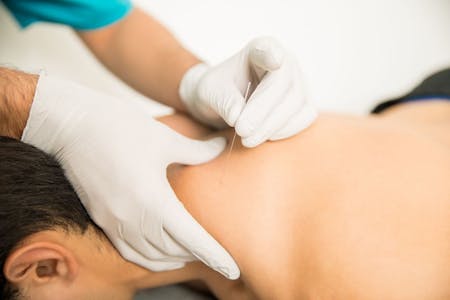
Eliminate Pain & Muscle Tightness
Functional Dry Needling can reduce or eliminate referred pain.
Functional Dry Needling is a skilled intervention performed by a physical therapist that uses a thin filament needle to penetrate the skin and stimulate underlying myofascial trigger points, muscular and connective tissues for the management of neuromuscular pain and movement impairments.
Is Dry Needling the Same as Acupuncture?
No, Functional Dry Needling uses an anatomical approach to evaluate the bones, joints, connective tissue and muscle to guide where the needle is placed.
On the other hand, Acupuncture uses Traditional Chinese Medicine evaluations of the pulse and tongue to guide where they will insert the needles along meridians of the body. Acupuncture's goal is to restore the normal flow of the life force called "Qi."
How do you know where to put the needles?
We use pre- and post-assessment findings to guide which muscles our physical therapists treat with dry needling.
How does it help?
Your therapist will identify the source of the pain, or trigger point with manual techniques. They will advance a small monofilament needle into this area to elicit a small, involuntary twitch response, which then relaxes the muscle. This can eliminate your pain, muscular tightness, and reduce referred pain.
What is referred pain?
Referred pain is like "secondary pain" that stems from the original source. (Example: Pain in your gluteal muscles can refer pain down the entire posterior leg!)
Elimination of these active trigger points can help to "reboot" the muscle to alleviate the original problem area as well as the secondary, referred pain area.
Does it last?
Most patients have dramatic pain relief and improved function after just a few treatments. The nature of your condition, acute injury vs. chronic injury will determine the frequency of dry needling treatments your physical therapist decides to use.
What makes it work so well?
- Increases blood flow – This helps to facilitate healing and decrease inflammation.
- Decreases muscle banding – After a local twitch response induced by needling, normal muscle cell length is restored allowing for normalized contraction of the muscle.
- Decreases spontaneous electrical activity – In a trigger point there is abnormal electrical activity occurring at the neuromuscular junction. Eliciting a twitch response quiets this heightened electrical activity.
- Biochemical changes – Active trigger points have high acidity, inflammatory markers, and Substance P. Substance P is a neurotransmitter that overstimulates your pain receptors.
- Studies have shown significant decrease in inflammatory markers, acidity levels and Substance P immediately and 5 days after treated with dry needling.
- Central Nervous System changes – Elimination of a trigger point in one area of the body can also decrease trigger points in other areas. (Example: Needling to a trigger point in the upper trapezius muscle eliminated trigger points in medial calf muscle.)
- Decreased Substance P and inflammatory markers at the site of treatment and at the nerve that exits the spinal cord that travels to the area of treatment.
- Certain areas of the brain that deal with pain modulation light up with dry needling treatment and help to decrease pain at the site of treatment.
What conditions can be treated with Functional Dry Needling?
Dry needling can be used for a variety of musculoskeletal problems. Muscles are thought to be a primary contributing factor to the symptoms.
Conditions which respond to dry needling include, but are not limited to:
- Headaches
- Frozen shoulder
- Tennis elbow
- Carpal tunnel syndrome
- Golfer’s elbow
- Buttock pain
- Leg pain
- Hamstring strains
- Shin splints
- Muscle spasms
- Fibromyalgia
- Sciatic pain
- Hip pain
- Knee pain
- Repetitive strain injuries
- And many more!
